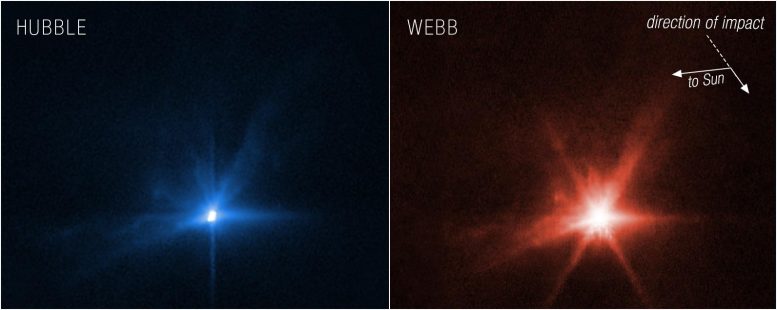
These images, Hubble on left and Webb on the right, show observations of the Didymos-Dimorphos system several hours after NASA’s Double Asteroid Redirection Test (DART) intentionally impacted the moonlet asteroid. It was the world’s first test of the kinetic impact technique using a spacecraft to deflect an asteroid by modifying its orbit. Both Webb and Hubble observed the asteroid before and after the collision took place.
Credit: Science: NASA, ESA, CSA, Jian-Yang Li (PSI), Cristina Thomas (Northern Arizona University), Ian Wong (NASA-GSFC), Image Processing: Joseph DePasquale (STScI), Alyssa Pagan (STScI)
First Time Webb and Hubble Make Simultaneous Observations of the Same Target
Two of NASA’s great observatories had a front-row seat to a groundbreaking NASA test for defending Earth against potential asteroid or comet hazards.
NASA’s James Webb Space Telescope and Hubble Space Telescope teamed up to collect data before and after NASA’s Double Asteroid Redirection Test (DART) intentionally smashed — at nearly 15,000 miles per hour — into the asteroid moonlet Dimorphos in the double-asteroid system of Didymos.
Ground-based telescope observations will help determine how successful the test was in altering the asteroid’s orbit. Additionally, the combined capabilities of Webb and Hubble together — on the same target, at the same time — will allow researchers to analyze a wide array of data relating to the makeup and history of our solar system.
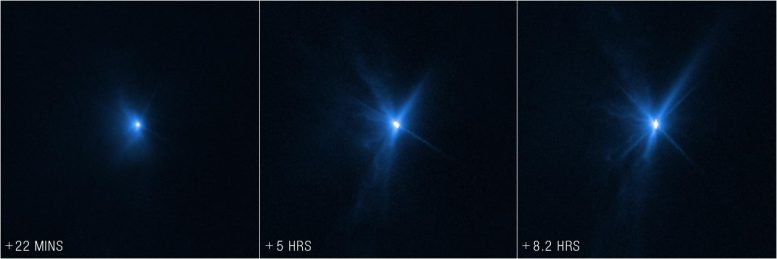
These images from NASA’s Hubble Space Telescope, taken 22 minutes, 5 hours, and 8.2 hours after NASA’s Double Asteroid Redirection Test (DART) intentionally impacted Dimorphos, show expanding plumes of ejecta from the asteroid’s body. This event was the world’s first test of the kinetic impact technique using a spacecraft to deflect an asteroid by modifying its orbit.
The Hubble images show ejecta from the impact that appear as rays stretching out from the body of the asteroid. The bolder, fanned-out spike of ejecta to the left of the asteroid is in the general direction from which DART approached. In the Hubble images, astronomers estimate that the brightness of the Didymos system increased by 3 times after impact. They’re also particularly intrigued by how that brightness then held steady, even eight hours after impact.
Credit: Science: NASA, ESA, Jian-Yang Li (PSI), Image Processing: Alyssa Pagan (STScI)
Webb and Hubble Capture Detailed Views of DART Impact
The James Webb Space Telescope and the Hubble Space Telescope, two of NASA’s Great Observatories, have captured views of a first-of-its-kind NASA experiment designed to intentionally crash a spacecraft into a small asteroid in the world’s first-ever in-space test for planetary defense. In fact, these observations of NASA’s Double Asteroid Redirection Test (DART) impact mark the first time that Webb and Hubble observed the same celestial target simultaneously.
DART intentionally crashed into Dimorphos, the asteroid moonlet in the double-asteroid system of Didymos on September 26, 2022, at 7:14 pm EDT. It was humanity’s first test of the kinetic impact mitigation technique, using a spacecraft collision to deflect an asteroid that poses no threat to Earth, and modifying the object’s orbit. DART is a test for defending Earth against potential asteroid or comet hazards.
“When I saw the data, I was literally speechless, stunned by the amazing detail of the ejecta that Hubble captured.” — Jian-Yang Li, Planetary Science Institute
While the coordinated Hubble and Webb observations are a significant operational milestone for each telescope, there are also key science questions relating to the makeup and history of our solar system that scientists can explore when combining the capabilities of these observatories.
“Webb and Hubble show what we’ve always known to be true at NASA: We learn more when we work together,” said NASA Administrator Bill Nelson. “For the first time, Webb and Hubble have simultaneously captured imagery from the same target in the cosmos: an asteroid that was impacted by a spacecraft after a seven-million-mile journey. All of humanity eagerly awaits the discoveries to come from Webb, Hubble, and our ground-based telescopes – about the DART mission and beyond.”
Combined observations from Webb and Hubble will allow researchers to acquire knowledge about the nature of the surface of Dimorphos, how much material was ejected by the impact, and how fast it was ejected. In addition, Webb and Hubble captured the impact in different wavelengths of light – Webb in infrared and Hubble in visible. Observing the impact across a wide array of wavelengths will reveal the distribution of particle sizes in the expanding dust cloud. This will help to determine whether it threw off lots of big chunks or mostly fine dust. Combining this information, along with ground-based telescope observations, will enable researchers to understand how effectively a kinetic impact can modify an asteroid’s orbit.
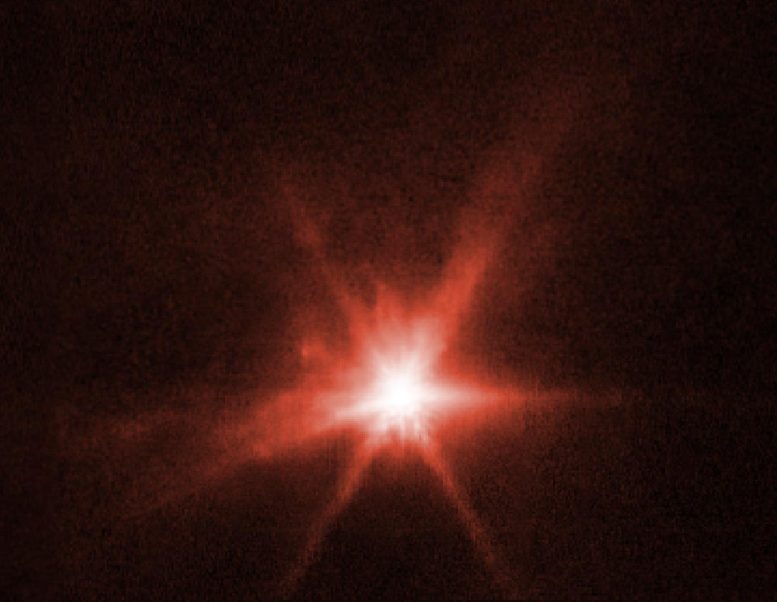
This image from NASA’s James Webb Space Telescope’s Near-Infrared Camera (NIRCam) instrument shows Dimorphos, the asteroid moonlet in the double-asteroid system of Didymos, about 4 hours after NASA’s Double Asteroid Redirection Test (DART) made impact. A tight, compact core and plumes of material appearing as wisps streaming away from the center of where the impact took place, are visible in the image. Those sharp points are Webb’s distinctive eight diffraction spikes, an artifact of the telescope’s structure.
Credit: Science: NASA, ESA, CSA, Cristina Thomas (Northern Arizona University), Ian Wong (NASA-GSFC), Image Processing: Joseph DePasquale (STScI)
Webb Captures Impact Site Before and After Collision
Webb took one observation of the impact location before the collision took place. Several more observations were taken over the next few hours. Images from Webb’s Near-Infrared Camera (NIRCam) reveal a tight, compact core, with plumes of material appearing as wisps streaming away from the center of where the DART hit the asteroid.
Because of the asteroid’s speed of travel across the sky, observing the impact with Webb presented the flight operations, planning, and science teams with unique challenges. As DART approached its target, the teams performed additional work in the weeks leading up to the impact to facilitate and test a technique of tracking asteroids moving at speeds over three times faster than the original speed limit set for Webb.
“This is an unprecedented view of an unprecedented event.” — Andy Rivkin, DART Investigation Team Lead of the Johns Hopkins University Applied Physics Laboratory
“I have nothing but tremendous admiration for the Webb Mission Operations folks that made this a reality,” said principal investigator Cristina Thomas of Northern Arizona University in Flagstaff, Arizona. “We have been planning these observations for years, then in detail for weeks, and I’m tremendously happy this has come to fruition.”
Astronomers also plan to observe the asteroid system in the coming months using Webb’s Mid-Infrared Instrument (MIRI) and Webb’s Near-Infrared Spectrograph (NIRSpec). Spectroscopic data will provide scientists with insight into the asteroid’s chemical composition.
Webb observed the impact over five hours total, capturing 10 images. The data was collected as part of Webb’s Cycle 1 Guaranteed Time Observation Program 1245 led by Heidi Hammel of the Association of Universities for Research in Astronomy (AURA).
Hubble Images Show Movement of Ejecta After Impact
Hubble also captured observations of the binary system ahead of the impact, then again 15 minutes after DART crashed into the surface of Dimorphos. Images from Hubble’s Wide Field Camera 3 (WFC3) show the impact in visible light. Ejecta from the impact appear as rays stretching out from the body of the asteroid. The bolder, fanned-out spike of ejecta to the left of the asteroid is in the general direction from which DART approached.
Some of the rays appear to be curved slightly, and astronomers will need to take a closer look to determine what this could mean. In the Hubble images, astronomers estimate that the brightness of the system increased by three times after impact. They continued to see that brightness hold steady, even eight hours after impact.
Over the next three weeks, Hubble plans to monitor the Didymos-Dimorphos system ten more times. These regular, relatively long-term observations as the ejecta cloud expands and fades over time will paint a more complete picture of the cloud’s expansion from the ejection to its disappearance.
“When I saw the data, I was literally speechless, stunned by the amazing detail of the ejecta that Hubble captured,” said Jian-Yang Li of the Planetary Science Institute in Tucson, Arizona, who led the Hubble observations. “I feel lucky to witness this moment and be part of the team that made this happen.”
Hubble captured 45 images in the time immediately before and following DART’s impact with Dimorphos. The Hubble data was collected as part of Cycle 29 General Observers Program 16674.
“This is an unprecedented view of an unprecedented event,” summarized Andy Rivkin, DART Investigation Team Lead of the Johns Hopkins University Applied Physics Laboratory.
The James Webb Space Telescope (JWST) is the world’s premier space science observatory. With its unmatched power, it will solve mysteries in our solar system, look beyond to distant worlds around other stars, and probe the mysterious structures and origins of our universe. JWST is an international program led by NASA with its partners, ESA (European Space Agency) and CSA (Canadian Space Agency).
The Hubble Space Telescope is a project of international cooperation between NASA and ESA. It is managed by NASA’s Goddard Space Flight Center in Greenbelt, Maryland. The Space Telescope Science Institute (STScI) in Baltimore, Maryland, conducts Hubble and Webb science operations. STScI is operated for NASA by the Association of Universities for Research in Astronomy, in Washington, D.C.

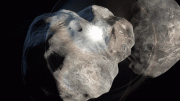
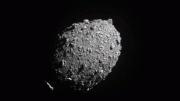
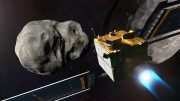
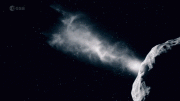
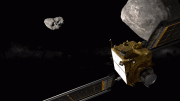
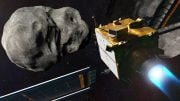
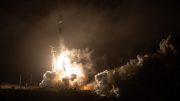
Webb’s defraction spikes are six-pointed rather than eight-pointed. Its mirror is made up of hexagons, not stop signs!